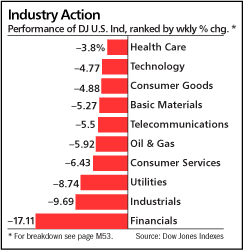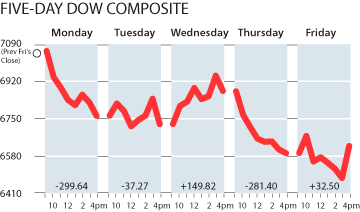If the initial public offering of credit-card processor Visa Inc. (V) goes off as scheduled today, it will be the biggest stock offering in U.S. history. And it could supercharge a moribund IPO market that’s been held down by the same credit-market concerns that have repeatedly threatened to send the key U.S. stock indices spinning down into bear-market territory.
The San Francisco-based Visa has filed to sell 406 million “Class A” common shares at $37 to $42 apiece, for proceeds of $15 billion to $17 billion. That would easily leapfrog the largest U.S. IPO to date, the $10.6 billion stock offering for AT&T Wireless, which occurred in April 2000.
If demand is strong, an additional 40 million shares could sell, generating a much as $19 billion in proceeds. That would actually push the Visa deal up near the biggest global IPO of all time, the October 2006 IPO of the Industrial & Commercial Bank of China, or ICBC, which raised $19.1 billion – or nearly $22 billion when the over-allotment provisions were fulfilled.
If the Visa deal is oversubscribed, the fallout could be highly bullish. The stock offering was supposed to be priced yesterday so the shares can begin trading today.
“If the Visa IPO does as well as everyone expects, comes out on schedule and is oversubscribed as I believe it will be, it could have a huge impact on the stock market in general and the IPO market specifically,” said Louis Basenese, an IPO expert who is the editor of the investment newsletters The Hot IPO Alert and The Takeover Trader. “It could give deal underwriters a renewed confidence in the IPO market and could green light the many deals now waiting on the sidelines. If it comes out on schedule and does well, it’s a green light. If it’s delayed for any reason – even if there’s no real problem – it’ll be a huge red light.”
When it comes to the Visa deal, Basenese sees no red lights, stop signs or warning signs of any type. In fact, according to his calculations, Visa’s shares could be worth $80 by the end of this year – and perhaps more, if all goes according to plan.
But even if that’s the case – and the IPO doesn’t re-ignite the U.S. stock-offering market – Visa’s shares can still be a profitable play for investors.
Here’s why.
According to Basenese, the Visa deal is one of the better IPOs to come down the pike in some time. For one thing, the company is the market leader, dwarfing its rivals in terms of both transaction volume and total transactions.
As the largest processor of retail payments the world, Visa Inc. dwarfs its rivals. It accounts for 60% of the debit-card transactions in the U.S. market – a four-to-one advantage over rival MasterCard. As the chart demonstrates, it is also bigger by total transactions and total volume.
Visa is an electronic payments network that focuses on retail transactions. It actually acts as a facilitator of global commerce, enabling money and information to move among banks, retailers, consumers, businesses and even government entities.
There are three basic points investors need to understand – especially with the chaotic credit markets investors now face, Basenese says:
Visa is not a credit-card issuer.
It’s not a lender.
And it’s not exposed to consumer-credit risk.
The bottom line: Visa is simply a transaction-processing company that collects a fee based on the number and dollar value of the transactions that it processes, he said. In short, this is a financial-services company whose shares investors can snap up with confidence and a feeling of safety, since there aren’t any worries that another credit-crunch-related catastrophe could obliterate its business and send its shares into the ground overnight, Basenese said.
Investors have been eager to grab shares in Visa’s offering as shares of the much-smaller rival MasterCard Inc. (MA) have more than quadrupled in value since the company went public in May 2006. MasterCard shares have largely been untouched by the stock-market turmoil generated by the ongoing credit crisis and closed yesterday (Monday) at $201.52, down $7.13, or 3.42%. They are down 11% from their 12-month high of $227.18.
With a public company, at the end of the day, it’s always about earnings. And Visa is poised to deliver profit growth. In its latest quarterly report, Visa generated $1.49 billion in revenue and $430 million in profits [excluding one-time events]. Company managers are conservatively projecting that profits will advance at a 20% clip.
But with his own analysis, Basenese uncovered three catalysts that will help Visa boost its profit-growth rate up to the 30% to 35% pace. Those three key catalysts:
No Chinks in its Armor: To generate profits, a company has to have strong sources of revenue. And Visa does. In fact, Basenese says there’s “not a weak spot in this company’s revenue mix.” Sales are increasing at healthy, double-digit rates across all business segments and in all geographic markets.
Killer Cost Controls: Since 2003, the total number of transactions Visa processes have soared 61%, but costs have increased only 12%. And since the company’s VisaNet payment-processing network is capable of handling double its current volume without really increasing its costs, incremental additions to revenue will translate into “dramatic increases” in earnings, Basenese says.
A Less-Taxing Tax Rate: Before the stock offering, Visa didn’t really have to fret about its tax rate, since it wasn’t a public company that had to engage in the quarterly cow-towing to Wall Street. As a result, it’s one of the few companies with a horrid tax rate of 41%. Even archrival MasterCard boasts a tax rate of only 35%. But now that it’s a public company, Visa will pull out all the stops in its efforts to pare its tax rate. If it gets down to MasterCard’s level, a 6% reduction in the tax rate on hundreds of millions of dollars in income will have a big impact on the bottom line, Basenese says.
The global payments sector is undergoing a true paradigm shift – away from cash and checks in favor of one that’s card-based and highly focused on electronic transactions. Since 2001, transactions using credit and debt cards went from 13% of payment volume to 27%, a compound annual growth rate of nearly 15%.
As dramatic as that metric is, it’s important to note that Visa grew at double that rate during the same period.
Expect the trend to continue – and to expand globally.
According to The Nilson Report, a newsletter that focuses on the payments industry, the purchasing card market will expand at an annual rate of at least 11% on a global basis between now and 2012. And much of the growth will be generated internationally – especially in the emerging markets.
Once again, Basenese says that his analysis has found that Visa is poised to grow faster than the market, which means that it’s going to grab market share from rivals.
First, two-thirds of Visa’s debit cards are in foreign hands, where consumer-spending levels are on the rise and where the use of electronic-payment technologies is still in its infancy.
And, second, research shows that six out of 10 consumers prefer Visa cards. That kind of brand loyalty means that Visa will be able to introduce new products with very little resistance. Visa already plans to introduce those products in four key areas: Prepaid cards, money-transfer technologies, e-commerce and mobile-transaction-processing.
At a time when U.S. consumer confidence is ebbing quickly and when fears of a major potential recession are escalating, investors need to note that Visa’s business is increasingly becoming almost recession proof. Here’s why:
Research underscores that 42% of Visa’s revenue is derived from non-discretionary spending, meaning that a lot of that revenue won’t disappear even if consumers and businesses make major cutbacks in their outlays for luxuries or other non-essential goods and services.
During the last two recessions, Visa continued to grow – both in terms of total transactions and total volume. And in each of the last 13 months – as a recession becomes more and more likely – Visa’s business has continued to grow at double-digit rates.
The Right Play at the Right Time
According to Basenese, Visa’s shares could be worth $80 by the end of this year – and perhaps more, if all goes according to plan. The stock actually will pay a small dividend – about 1%, based on the projected IPO price. That’s a rarity among newly public companies. But Money Morning Investment Director Keith Fitz-Gerald puts a premium on stocks that generate income.
Basenese likes the company, its business plan, its market position, and its financial strength.
“The pitch for Visa is simple,” he said. “It’s a rare opportunity to own a piece of a relative monopoly.”
Subscribe to:
Post Comments (Atom)


No comments:
Post a Comment